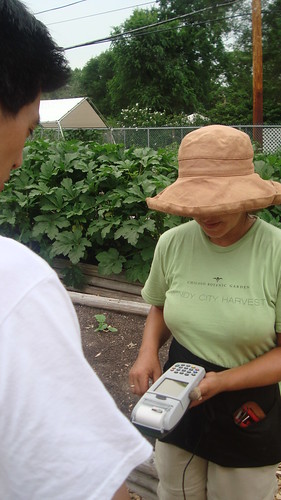
Recently, fellow staff member, Victor Ho, and I ventured out to the Midwest Region’s People’s Garden on the west side of Chicago. It was a sunny, 80 degree day and we were ready to harvest a bumper crop of vegetables. We also wanted to check out the garden’s new wireless Electronic Benefit Transfer (EBT) system which enabled the garden to begin accepting Supplemental Nutrition Assistance Program (SNAP, formerly Food Stamp Program) benefits—the first USDA People’s Garden to do so!
Working with its FNS partners, the Chicago Botanic Garden decided it would be a positive step for the site to accept SNAP via a wireless device and so it recently applied and was approved as a farmer’s market. SNAP participants can now use their benefit cards to purchase any produce harvested at the site’s twice-weekly markets.
It’s a great feeling to know that the healthy produce grown in our Midwest People’s Garden is going to individuals and families who need it most! And it’s even more rewarding to know that by accepting SNAP at this People’s Garden, we’re helping to stimulate the local economy and bring fresh, healthy produce to an area that has been defined as a food desert.
USDA’s Midwest garden is maintained in partnership with the organic-method growing enterprise Windy City Harvest and Chicago Botanic Garden. Interns and staff employed by Windy City or the Garden work at the site every day and have engaged members of the community who purchase produce during the markets or have cultivated their own mini vegetable plots. These same hard-working staff have spear-headed the garden’s creation and taught FNS staff about seeding, growing, caring for and harvesting vegetables. (Garden manager Sheri Yarerough even gave me a collard greens shoot to practice growing at my desk in the office.)
The garden—now in its second year—has seen an abundance of crops this season. Windy City Harvest and FNS staff have already harvested 956 pounds of cucumber! Other garden veggies include Swiss chard, collard greens, a variety of lettuces, carrots, onions and beets.
While there is plenty of fresh produce to purchase, SNAP usage has only begun to catch on. Windy City Harvest staff intend to increase participation next summer through marketing efforts and by word of mouth. Staff also intend to form partnerships with churches in order to be sure that the community is aware of the garden’s twice weekly markets and that it accepts SNAP.
“The people have to get used to us,” Sheri told me. “They want to know we’re going to stick around, which we are.”
In the meantime, garden staff donate extra produce to shelters and soup kitchens.
“And we keep our EBT batteries charged,” says Sheri with a grin. “You never know when someone’s going to stop by!”
